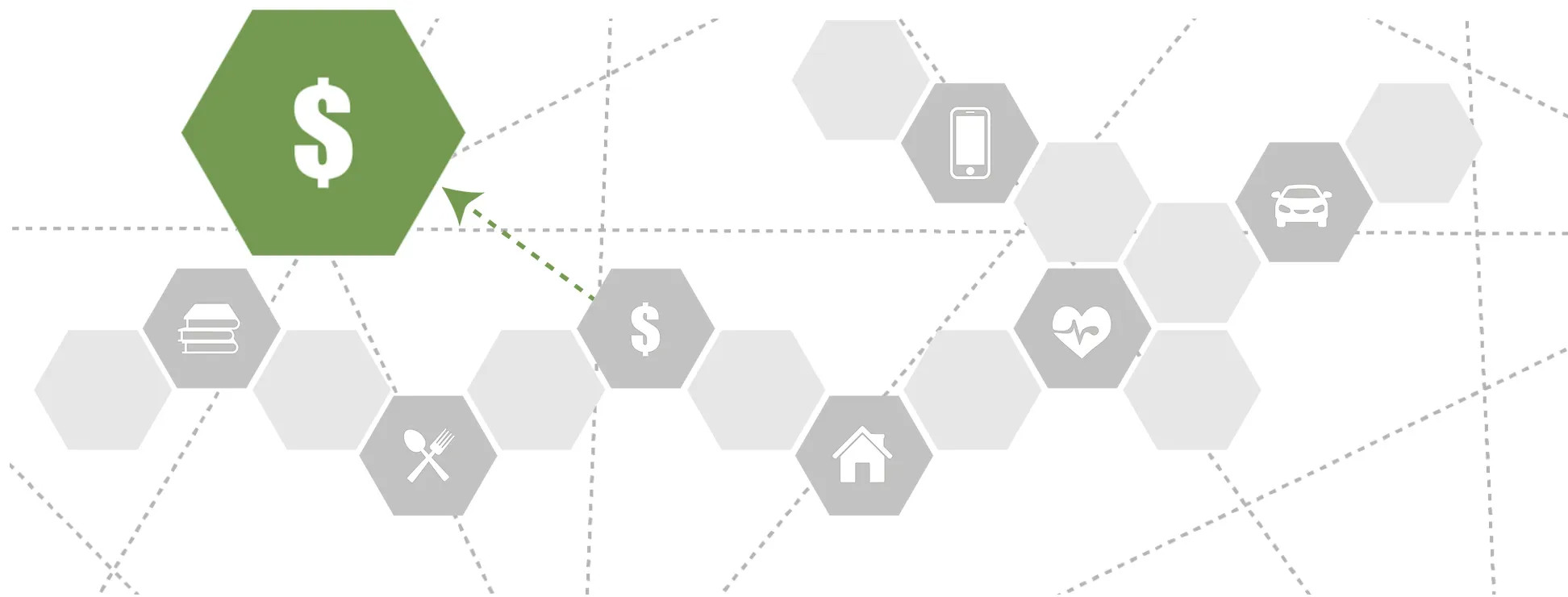
|
Housingclick to view |

|
Health Careclick to view |

|
Child Care and Educationclick to view |

|
Technologyclick to view |

|
Foodclick to view |

|
Taxesclick to view |

|
Transportationclick to view |
||
Introduction
While headlines often feature low-income households receiving government assistance, United For ALICE shows that ALICE households also contribute greatly to our economy by working, buying goods and services — and paying taxes. On average, these households pay about 22 percent of what they earn in income, property, and wage taxes.
The burden of paying taxes weighs especially heavily on ALICE families. Because they earn above the Federal Poverty Level (FPL), ALICE families have too high of an income to qualify for benefits like the Earned Income Tax Credit (EITC) and renter tax credits, or for public assistance programs including SNAP and Medicaid that would reduce their overall tax burden. At the same time, they earn too little to accumulate assets that would also bring tax relief — for example, to purchase a house and enjoy a mortgage tax deduction, or to own capital investments such as stocks or bonds that grow tax free.1
ALICE and Income Tax
ALICE families are required to pay income taxes. Overall, the federal income tax structure in the U.S. is progressive, meaning that those earning higher incomes pay a higher rate of tax. However, this is generally not the case for state, local, and payroll taxes:
- Nationwide, the lowest-income taxpayers (the 20 percent of households with the lowest income) pay state and local tax rates that are over 50 percent higher than the top one percent of households.2
-
In states with the most regressive taxes (lower-income households pay a higher rate of tax) —Washington, Texas, Florida, South Dakota, Nevada, Tennessee, Pennsylvania, Illinois, Oklahoma, and Wyoming — the tax rates for the bottom 20 percent of the income scale are up to six times higher than those for the top 1 percent.
- For state sales and excise taxes specifically, the lowest-income group pays an average of almost 8 percent of their income, while those in the highest 20 percent income bracket pay less than 3 percent.3
- For payroll taxes, the 20 percent of households with the lowest incomes paid almost 10 percent of their income in federal payroll taxes, while the 20 percent with the highest incomes paid 6.5 percent, and the wealthiest 1 percent of households paid only 2.2 percent.4
Only those earning less than $20,800 per year for a couple, or $10,400 per year for an individual — both below the FPL — were not required to file an income tax return in 2017.5
ALICE and...
- Sales tax: There is no sales tax on most items in the Household Survival Budget (housing, food, child care, and health care). However,13 states have at least some taxes on food.6 In addition, ALICE pays the state sales tax on goods outside the budget.
- Property tax: The majority of ALICE households are renters and the housing component of the Household Survival Budget is based on the cost of rental housing. While there is no property tax factored into the budget, these taxes are passed on to renters in the form of higher rents. High property taxes are a barrier to purchasing a home for ALICE households.
- Tax burden: Workers, including ALICE, bear the greatest burden of taxation, paying for the majority of government revenue through taxes on labor — individual income taxes (47 percent of revenue) and payroll taxes (33 percent). By contrast, taxes on wealth — property taxes, capital gains taxes, and corporate taxes — contribute less than 20 percent of government revenue, despite the fact that wealth cushions households and can be leveraged to help them build even more wealth.7
When ALICE and poverty-level households cannot afford to pay their taxes, they incur the risk of being audited and fined, as well as paying interest in addition to the original amount due. When tax revenue drops due to late or missed tax payments, it is harder for the government to invest in the services all households rely on, such as schools, health care, and transportation.
Sources
1
Internal Revenue Service. (2017). Instructions for Form 1040 . Retrieved from https://www.irs.gov/pub/irs-prior/i1040gi--2017.pdf
Center on Budget and Policy Priorities. (2018). Policy basics: Where do federal tax revenues come from? Retrieved from https://www.cbpp.org/research/federal-tax/policy-basics-where-do-federal-tax-revenues-come-from
2
Institute on Taxation and Economic Policy (ITEP). (2018). Who pays? A distributional analysis of the tax systems in all 50 states (6th ed.). Retrieved from https://itep.org/whopays/
3
Institute on Taxation and Economic Policy (ITEP). (2018). Who pays? A distributional analysis of the tax systems in all 50 states (6th ed.). Retrieved from https://itep.org/whopays/
4
Tax Policy Center (TPC), Urban Institute and Brookings Institution. (2018). Historical average federal tax rates for all households. Retrieved from https://www.taxpolicycenter.org/statistics/historical-average-federal-tax-rates-all-households
5
Internal Revenue Service. (2017). Instructions for Form 1040. Retrieved from https://www.irs.gov/pub/irs-prior/i1040gi--2017.pdf
6
Figueroa, E., & Waxman, S. (2017, March 1). Which states tax the sale of food for home consumption in 2017? Center on Budget and Policy Priorities. Retrieved from https://www.cbpp.org/research/state-budget-and-tax/which-states-tax-the-sale-of-food-for-home-consumption-in-2017
7
Center on Budget and Policy Priorities. (2018). Policy basics: Where do federal tax revenues come from? Retrieved from https://www.cbpp.org/research/federal-tax/policy-basics-where-do-federal-tax-revenues-come-from
Internal Revenue Service. (2019). Topic Number 409: Capital gains and losses. Retrieved from https://www.irs.gov/taxtopics/tc409

